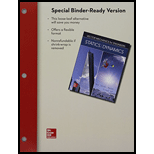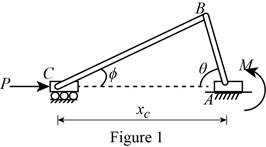
Concept explainers
(a)
Find the couple M required to maintain the equilibrium.
(a)
Answer to Problem 10.21P
The magnitude of the couple M is
Explanation of Solution
Given information:
The magnitude of the force P is 4 kN.
The distance between the point A and B is 50 mm.
The distance between the point B and C is 200 mm.
The value of the angle
Calculation:
Show the free-body diagram of the engine system as in Figure 1.

Consider the geometry of the Figure 1.
Use the Law of sines;
Differentiate the equation;
Find the horizontal displacement
Differentiate the equation;
Substitute
Use the principle of virtual work;
Substitute
Substitute 50 mm for AB, 200 mm for BC, and
Substitute 4 kN for P, 50 mm for AB, 200 mm for BC,
Therefore, the magnitude of the couple M is
(b)
Find the couple M required to maintain the equilibrium.
(b)
Answer to Problem 10.21P
The magnitude of the couple M is
Explanation of Solution
Given information:
The magnitude of the force P is 4 kN.
The distance between the point A and B is 50 mm.
The distance between the point B and C is 200 mm.
The value of the angle
Calculation:
Refer part (a) for calculation;
Substitute 50 mm for AB, 200 mm for BC, and
Substitute 4 kN for P, 50 mm for AB, 200 mm for BC,
Therefore, the magnitude of the couple M is
Want to see more full solutions like this?
Chapter 10 Solutions
VECTOR MECH...,STAT.+DYNA.(LL)-W/ACCESS
- Two rods AC and CE are connected by a pin at C and by a spring AE . The constant of the spring is k , and the spring is unstretched when θ = 30°. For the loading shown, derive an equation in P,θ ,I, and k that must be satisfied when the system is in equilibrium.arrow_forwardIn the planetary gear system shown, the radius of the central gear A is a= 18 mm, the radius of each planetary gear is b , and the radius of the outer gear E is (a + 2b). A clockwise couple with a magnitude of MA = 10 N.m is applied to the central gear A and a counterclockwise couple with a magnitude of MS= 50 N.m is applied to the spider BCD . If the system is to be in equilibrium, determine (a) the required radius b of the planetary gears, (b) the magnitude ME of the couple that must be applied to the outer gear E.arrow_forwardA freight wagon is at rest on a track at an angle of 25o to the vertical. The gross weight of the wagon and its load is 36kN and acts at a point 750 mm from the track, in the middle between the two axles. The wagon is held by a cable 600 mm from the track. Determine the traction on the cable and the reaction on each pair of wheels.arrow_forward
- The control rod CE passes through a horizontal hole in the body of the toggle system shown. Knowing that link BD is 250 mm long, determine the force Q required to hold the system in equilibrium when β= 20°.arrow_forwardEight identical 500 × 750-mm rectangular plates, each of mass m = 40 kg, are held in a vertical plane as shown. All connections consist of frictionless pins, rollers, or short links. In each case, determine whether (a) the plate is completely, partially, or improperly constrained, (b) the reactions are statically determinate or indeterminate, (c) the equilibrium of the plate is maintained in the position shown. Also, wherever possible, compute the reactions.arrow_forwardThe 10-lb bar AE is suspended by a cable that passes over a 5-in.-radius drum. Vertical motion of end E of the bar is prevented by the two stops shown. Knowing that μs= 0.30 between the cable and the drum, determine (a) the largest counterclockwise couple M0 that can be applied to the drum if slipping is not to occur, (b) the corresponding force exerted on end E of the bar.arrow_forward
- Denoting the coefficient of static friction between collar C and the vertical rod by μs , derive an expression for the magnitude of the largest couple M for which equilibrium is maintained in the position shown, when θ=35°, I= 600 mm, and P = 300 N.arrow_forwardDetermine the value of θ corresponding to the equilibrium position of the rod of Prob. 10.12 when P = 80 N, and Q= 100 N.Reference to Problem 10.12:Knowing that the line of action of the force Q passes through point C , derive an expression for the magnitude of Q required to maintain equilibrium.arrow_forwardTwo rods are connected by a slider block as shown. Given: MB= 250 lb-in. MA MB 25° 15 in. A |B 15 in.- Draw the free-body diagram needed to determine the couple MA required to hold the system in equilibrium.arrow_forward
- 9. A man is trying to pull the sled by applying a force of 500 N, as shown. The weight of the stone and the sled is 800 N while the sled is about to slide (i.e., it is still in equilibrium). Determine the magnitude of the reaction force R. a. b. W = 800 N 650 N 700 N 0 R P = 500 N 30⁰ Cc. d. 750 N 800 Narrow_forwardP A P C HINT: Collar A is in equilibrium 20.5 20 4+₂5 50 lb Free Body: Collar A 150 lb A 20 in. PROBLEM 2.63 Collar A is connected as shown to a 50-lb load and can slide on a frictionless horizontal rod. Determine the magnitude of the force P required to maintain the equilibrium of the collar when (a) x=4.5 in., (b) x=15 in. Where does N come from? What is it?arrow_forwardCollars A and B are connected by a 525-mm-long wire and can slide freely on frictionless rods. A force P = (353 N)j is applied to collar A. ů y Show Transcribed Text c 200 mm Determine the magnitude of the force Q required to maintain the equilibrium of the system when y = 155 mm. (Round the final answer to two decimal places.) The magnitude of the force Q required to maintain the equilibrium of the system is N. ‒‒‒arrow_forward
 Elements Of ElectromagneticsMechanical EngineeringISBN:9780190698614Author:Sadiku, Matthew N. O.Publisher:Oxford University Press
Elements Of ElectromagneticsMechanical EngineeringISBN:9780190698614Author:Sadiku, Matthew N. O.Publisher:Oxford University Press Mechanics of Materials (10th Edition)Mechanical EngineeringISBN:9780134319650Author:Russell C. HibbelerPublisher:PEARSON
Mechanics of Materials (10th Edition)Mechanical EngineeringISBN:9780134319650Author:Russell C. HibbelerPublisher:PEARSON Thermodynamics: An Engineering ApproachMechanical EngineeringISBN:9781259822674Author:Yunus A. Cengel Dr., Michael A. BolesPublisher:McGraw-Hill Education
Thermodynamics: An Engineering ApproachMechanical EngineeringISBN:9781259822674Author:Yunus A. Cengel Dr., Michael A. BolesPublisher:McGraw-Hill Education Control Systems EngineeringMechanical EngineeringISBN:9781118170519Author:Norman S. NisePublisher:WILEY
Control Systems EngineeringMechanical EngineeringISBN:9781118170519Author:Norman S. NisePublisher:WILEY Mechanics of Materials (MindTap Course List)Mechanical EngineeringISBN:9781337093347Author:Barry J. Goodno, James M. GerePublisher:Cengage Learning
Mechanics of Materials (MindTap Course List)Mechanical EngineeringISBN:9781337093347Author:Barry J. Goodno, James M. GerePublisher:Cengage Learning Engineering Mechanics: StaticsMechanical EngineeringISBN:9781118807330Author:James L. Meriam, L. G. Kraige, J. N. BoltonPublisher:WILEY
Engineering Mechanics: StaticsMechanical EngineeringISBN:9781118807330Author:James L. Meriam, L. G. Kraige, J. N. BoltonPublisher:WILEY





